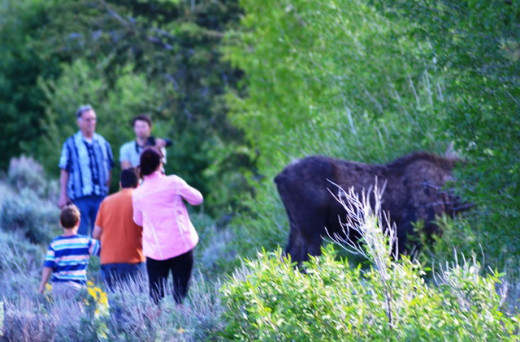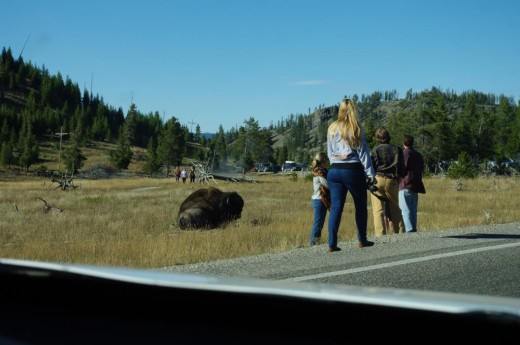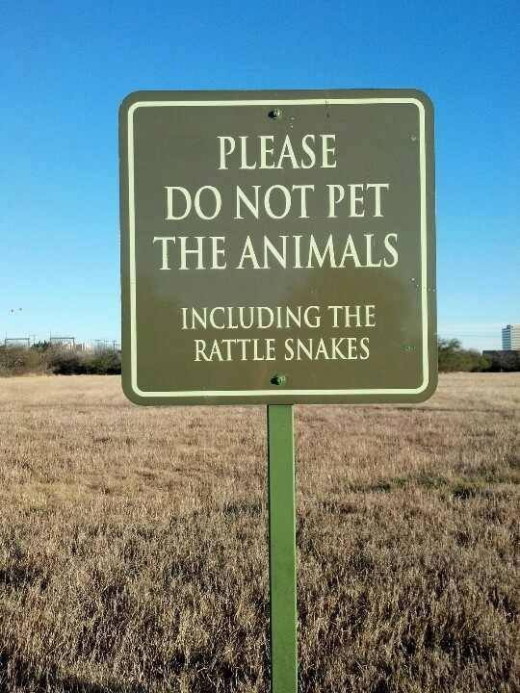Most people flee when they spot a sign warning of rattlesnakes in the area. On the other hand, a good number of people completely disregard signs warning of bears, bison, moose, elk, or any other charismatic animal, approaching too closely to an animal and possibly blocking its escape route. Recently, an agitated cow moose was euthanized after nearly severing her leg while attempting to escape a photo-intense crowd who ignored signs and intruded on her space.
For the most part, snakes and other animals want nothing to do with people. Snakes generally slither away and disappear unless cornered. Other animals may stick around while people snap photos and crowd around to view them; but once their space is threatened, they may charge or attack unsuspecting gawkers.
Witness
“We once watched a bison rolling in the dirt,” a friend told us recently. “As he rolled, people closed in to get pictures and a better look, ignoring warning signs. It wasn’t long before the crowd had completely surrounded the bison. We left, but later heard that when the animal arose and discovered he had no escape route, he plunged into the crowd and injured one of the spectators.”
Portrayals
Television and movies often portray charismatic animals in a cute or endearing manner, sending the message to viewers that these animals are tame and forgiving. In reality, many of these animals can be dangerous and unpredictable. A moose may stomp a person who encroaches on its space or appears to threaten its young. A bear may charge when surprised or protecting its cubs. A cougar may attack a runner, viewing the person as prey.
[twocol_one] [/twocol_one] [twocol_one_last]
[/twocol_one] [twocol_one_last] [/twocol_one_last]
[/twocol_one_last]
On the other hand, the same media generally portray snakes and other less enchanting animals as scary and evil, waiting to attack passersby any chance they get. In reality, most of these animals are shy and seek distance from humans. Most abandon their offspring to fend for themselves after hatching or giving birth and have no intention to attack for that reason. An attack from a snake is generally a defensive measure after being surprised or molested.
Harming snakes
Recently, Chuck observed a small group of tourists gathered around a fracture in the concrete adjacent to the visitor center. One person in the group was smoking a cigarette. Because we had observed gartersnakes coming and going from this opening, Chuck suspected these people were looking at one of the snakes through the crack. This was confirmed when he saw the smoker drop his lighted cigarette through the opening.
Chuck raced toward the group, admonishing them to move away from the area. When he peered down the crack and saw the burning embers on the back of a snake, he scooped water from the nearby pond and drenched the area around the animal.
Observing Signs
No doubt if a sign had been placed in front of the den warning of snakes, people would have recoiled from the area. While many people harbor hatred and fear of these animals, many of which are harmless, other people disregard signs warning of dangers from animals that have great potential to injure or kill them.
Signs are placed for a reason. It behooves visitors and everyone to pay attention and heed the warnings. They’re there to protect the animals as well as people.
Thanks to Bobby Harkey for the pictures of people approaching too close to the moose. And Thanks to Denise Bausch for the picture of people approaching too close to bison.






Great article. Enjoyed reading it. Proud to know you!
Thanks for the kind words! We feel strongly about giving animals the respect they deserve.
I was so saddened by the death of the cow moose, but I have always heeded the warnings about their buffer zones anyway. This was sobering to be sure, and I wish I could make more people read it.
Thanks for your comments! I wish more people shared them. Maybe this unfortunate incident will serve as a wakeup call to those who “just HAVE to get one more photo.”
I was saddened by the death of that cow moose, all because people were “ignorant” and chose not to obey the signal signs. I would think everyone would know that and animal that large would have massive strength and power and should be respected and given its space. Everything from a tiny little scorpion to a hulking bull/cow moose should be given space and not “antagonized”. The man who dropped his cigaret ember on the snake, he really hit a nerve with me, I am devoting my life to reptiles and to here someone do that and show no remorse just breaks my heart. That snake did nothing to deserve that. And FYI smoking is no better but I wont impose that, its your choice if you want to. How the little fella doing Chuck? has he recovered from his horrific ordeal of being burned?
Daniel, I wish more people would share your concerns and wisdom concerning reptiles and any other mis-understood animal! Here on the border of the Teton Nat’l Park, unfortunately we observe and hear of too many people who think either that “evil” animals should be automatically killed or persecuted and larger mammals are there to be approached any time we feel the need. The animals in this area are wild, not pets, not cartoon characters! There’s not a summer here that some ignorant tourist gets too close to a bison or moose and gets hooked and thrown or run over. Moose are the most dangerous animals in this region…..bad eyesight and bad temperament. If they feel threatened, they simply charge the source of perceived danger to eliminate the threat. As for the garter snake that endured the cigarette drop, I’m glad to say that I was able to pour water on it before there was any apparent damage. And, I’m not sure if it was the same snake or not, but a month later one of the garter snakes in that area gave live birth to about six offspring right in front of us. A rarely seen event in the wild! Before long, the snakes in this area (and yours as well) will go underground for the winter. We’re already looking forward to their emergence next spring! Thanks for your comments and have a great winter!
Hello! I came across your wonderful work while searching for information about full-time RV living with snakes. My small family is planning to move into an RV, full-time, at the start of next year, and we will be traveling with snakes. One is a very large common boa, whom we plan on building a new vivarium to fit the RV specifically, as she requires a large space, and we will have at least 1 if not 2 younger boas or pythons as well. Any advice you can share when it comes to the practicalities of caring for snakes while RV living would be greatly appreciated! Thanks!
Howdy,
In looking at your Facebook page, I can tell that you’re not a newcomer to the herpetological world. It’s always good to get the word out regarding the benefits of having snakes share the planet with us. Traveling with them on the other hand can present a few challenges. For years, we traveled with four snakes ranging in size from a 16″ Western Hognose to a 5+ft bullsnake. All the cages fit snugly in the basement part of our 33 foot 5th wheel trailer. Of course, that eliminated the space I normally would have used for personal items, clothes and various supplies necessary for this lifestyle. Bigger snakes require bigger cages so it is important to know the dimensions of each cage’s footprint before making any final decisions. Some cages can be stacked depending on the vertical clearance. You will need a reliable source of basking light and perhaps some heat lamps. It’s much easier to warm the snakes than it is cooling them down if you get into a hot climate. It’s possible that some RVs could have an airconditioned basement similar to commercial aircraft, but I’ve never heard of that feature. Then, there’s the consideration of food. RV refrigerator/freezers can be somewhat small although I’ve seen some that are similar to what a house would use. Carefully calculate how much food is needed for a period of time, and as well, a source of rodents that can be shipped to wherever you’re located. Usually, frozen rodents are shipped by FedEX, either overnight or second day service. The cost for the shipping alone can exceed the cost of the rodents in some cases. Those younger boas or pythons you mentioned will get larger, faster than we sometimes realize and then there’s another challenge for the housing……We have had good luck with our snakes while traveling because we volunteer at wildlife refuges that allow us to display the animals in a visitor center or at least house them in a vacant office. This method makes having them travel with us much easier. Presently, we are on a month long trip from western WY to central FL for the winter at a refuge, so I’ll be glad to get the critters out of our basement and in a fixed location for the next 5 months. Keeping them full time in our RV is not a good option and I have been constantly tweaking the light timers to provide an adequate light/heat exposure. In extreme weather hot or cold, I bring the snakes into the cab of the truck where there’s A/C or heat as required. It’s not always easy, but we have had great success with countless schools thanks to the scaly educators that travel with us! If you have any more questions, don’t hesitate to send ’em. Keep in mind that we’re not always able to respond in a timely manner if we’re out of wi-fi range, but will respond when we can.
Thanks for your comments and concerns! Chuck (refuge42@yahoo.com)